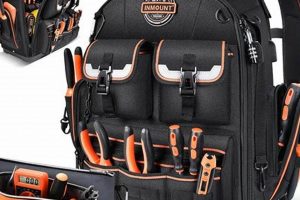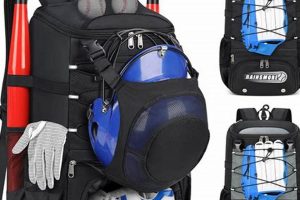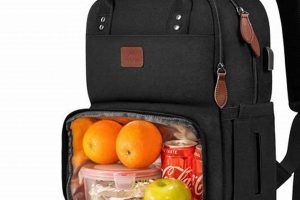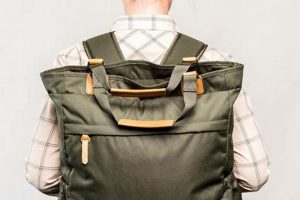These specialized carrying solutions provide a secure and watertight environment for contents, shielding them from water intrusion. Characterized by durable, waterproof materials and sealed closures, they are engineered to withstand submersion or exposure to wet conditions. Examples range from smaller models designed for personal electronics to larger capacity versions suitable for multi-day expeditions.
The value of such equipment lies in its ability to protect sensitive items from damage due to moisture, extending the lifespan of gear and ensuring functionality in challenging environments. Historically, these items were crucial for maritime activities and have since evolved to serve a wide array of outdoor pursuits, including hiking, kayaking, and travel in inclement weather, offering peace of mind to users.
The subsequent sections will detail the different types available, selection criteria based on intended use, maintenance best practices, and explore their significance across various applications.
Effective Utilization
Optimizing the performance and longevity of this specialized gear requires adherence to specific practices. Following these guidelines will ensure reliable protection for essential equipment in diverse conditions.
Tip 1: Proper Closure is Paramount: Ensure the roll-top closure is correctly aligned and tightly folded a minimum of three times before securing the buckle. Insufficient folds compromise the water-tight seal.
Tip 2: Select the Appropriate Size: Overfilling compromises closure integrity. Choose a size that allows for secure sealing without excessive compression of contents.
Tip 3: Conduct Pre-Use Inspection: Prior to each excursion, examine the material for punctures, abrasions, or seam weaknesses. Repair any damage immediately to prevent water ingress.
Tip 4: Utilize Inner Liners for Added Protection: For sensitive electronics, consider using a secondary waterproof case inside the main compartment as an additional safeguard.
Tip 5: Avoid Prolonged Submersion at Depth: While designed to be waterproof, prolonged submersion at significant depths can exceed pressure limits. Use caution in underwater environments.
Tip 6: Clean and Dry After Each Use: Remove any dirt, debris, or moisture from both the interior and exterior surfaces. This prevents mold growth and material degradation.
Tip 7: Store Properly When Not in Use: Store the backpack in a cool, dry location away from direct sunlight. Avoid compressing or folding it tightly for extended periods to prevent creasing and weakening of the material.
Consistent implementation of these techniques will maximize the effectiveness of the dry bag waterproof backpack, safeguarding vital equipment and enhancing overall outdoor experience.
The following section will discuss specific applications and user scenarios.
1. Material Durability
The material composition of a dry bag waterproof backpack directly correlates with its protective capability and lifespan. Robust materials are essential to withstand the abrasive forces encountered during outdoor activities, such as hiking, kayaking, and mountaineering. Punctures, tears, and seam failures compromise the water-tight integrity of the backpack, rendering it ineffective. For example, a backpack constructed from thin, low-denier nylon is significantly more susceptible to damage from sharp rocks or branches compared to one made from thick, reinforced TPU (Thermoplastic Polyurethane) or PVC (Polyvinyl Chloride). Understanding the inherent limitations of different materials is paramount for selecting an appropriate pack for the intended application.
Material selection further influences the backpack’s resistance to environmental degradation. Prolonged exposure to ultraviolet (UV) radiation, saltwater, and extreme temperatures can weaken certain fabrics, leading to premature failure. Fabrics treated with UV inhibitors or constructed from inherently UV-resistant polymers exhibit increased longevity. For instance, Hypalon, a synthetic rubber known for its chemical resistance and UV stability, is often used in high-end dry bags designed for marine environments. Similarly, reinforced stitching and welded seams contribute to overall durability by minimizing stress points and preventing water infiltration through weak points in the construction.
Ultimately, material durability is a critical factor that directly impacts the reliability and performance of a dry bag waterproof backpack. Investing in a pack constructed from high-quality, abrasion-resistant, and environmentally stable materials translates to enhanced protection for valuable gear and increased peace of mind during outdoor pursuits. Choosing the right materials guarantees optimal performance and extended usability, addressing the challenges of moisture protection effectively.
2. Closure Integrity
Closure integrity is a foundational element in determining the effectiveness of a dry bag waterproof backpack. The closure mechanism is the primary defense against water intrusion, and its design and execution directly impact the backpack’s ability to safeguard contents in wet environments.
- Roll-Top Design Effectiveness
The roll-top closure, a common design element, relies on multiple folds of the bag’s opening to create a watertight seal. Insufficient or improperly executed folds compromise this seal. The material’s flexibility and the buckle’s secure fastening are crucial components. For instance, using a thin, easily creased material or a buckle that doesn’t firmly lock renders the roll-top closure vulnerable. Real-world implications range from damp clothing in a light rain to complete gear saturation during submersion.
- Zipper System Reliability
Waterproof zippers, while offering convenient access, require robust construction and sealing mechanisms. These zippers often incorporate polyurethane (PU) coatings or rubber gaskets to prevent water penetration through the zipper teeth. However, wear and tear, debris accumulation, or improper lubrication can compromise the zipper’s seal. A damaged or poorly maintained waterproof zipper represents a significant failure point, particularly in situations involving prolonged exposure to water spray or brief submersion.
- Material Compatibility at Closure Points
The interaction between the closure mechanism and the surrounding bag material is critical. For roll-top closures, the material must be flexible enough to allow for tight folding yet durable enough to withstand repeated flexing without tearing or creasing permanently. Similarly, around zipper closures, the material must provide a firm and even surface for the zipper to seal against. Incompatibility between the closure mechanism and the material can lead to uneven sealing, creating weak points for water entry.
- Maintenance and Longevity
All closure systems require regular maintenance to ensure continued waterproof performance. Roll-top closures should be cleaned to remove dirt and debris that can interfere with the seal. Waterproof zippers should be lubricated periodically with appropriate silicone-based lubricants to maintain smooth operation and prevent the gasket materials from drying out and cracking. Neglecting maintenance shortens the lifespan of the closure and significantly increases the risk of water damage to the bag’s contents.
In conclusion, closure integrity is not merely a design feature but a performance imperative for any dry bag waterproof backpack. Careful design consideration, material selection, consistent maintenance, and user awareness all contribute to the long-term effectiveness of the backpack’s ability to protect its contents from water damage. A compromised closure mechanism negates the advantages of otherwise robust materials and construction, rendering the backpack unsuitable for its intended purpose.
3. Capacity Variance
Capacity variance in dry bag waterproof backpacks dictates their suitability for diverse applications, influencing the quantity and type of gear protected from moisture. Understanding these variations is crucial for selecting the appropriate pack for specific needs and environments.
- Small Capacity (5-20 Liters)
These compact backpacks are designed for short excursions or activities where minimal gear protection is required. Examples include day hikes, kayaking trips, or beach outings. They typically accommodate essentials like phones, wallets, keys, and small electronic devices. The implications involve prioritizing critical items and minimizing weight and bulk.
- Medium Capacity (20-40 Liters)
Medium-sized backpacks offer greater versatility for overnight trips or activities requiring more extensive gear. These can hold changes of clothing, small camping equipment, cameras, and navigation tools. The implications allow for expanded capabilities but require careful packing and weight distribution.
- Large Capacity (40-70 Liters)
Large-capacity backpacks are suited for multi-day adventures or expeditions where substantial gear is necessary. These accommodate tents, sleeping bags, cooking equipment, and extensive clothing reserves. The implications involve significant carrying capacity but necessitate a robust support system and physical endurance.
- Extreme Capacity (70+ Liters)
Backpacks exceeding 70 liters are specialized for extended expeditions in remote environments. They accommodate bulky items like winter camping gear, climbing ropes, and specialized scientific equipment. The implications entail extreme weight and volume considerations, requiring advanced planning and physical conditioning.
Capacity variance significantly affects the portability and usability of dry bag waterproof backpacks. Choosing the appropriate capacity ensures adequate protection without compromising maneuverability or comfort. The specific activity and anticipated environmental conditions should guide the selection process, optimizing the balance between gear protection and user experience.
4. Seam Construction
Seam construction is a critical determinant of a dry bag waterproof backpack’s ability to prevent water intrusion. The methods employed in joining fabric panels directly influence the bag’s overall watertight integrity and durability.
- Welded Seams
Welded seams utilize heat and pressure to fuse fabric panels together, creating a continuous, impermeable bond without the need for stitching. Radio-frequency welding and thermal welding are common techniques. For instance, TPU (Thermoplastic Polyurethane) fabrics are often welded, resulting in a robust, watertight seam. The implication is enhanced protection against water ingress, particularly under pressure or during submersion.
- Taped Seams
Taped seams involve applying a waterproof tape over stitched seams to seal needle holes. The tape is typically heat-activated and bonded to the fabric. Examples include applying polyurethane tape to nylon or polyester fabrics. The role reduces water penetration through stitching, adding a layer of protection but is potentially less durable than welded seams.
- Stitched and Sealed Seams
Stitched and sealed seams combine conventional sewing with a waterproof coating or sealant applied to the seam area. This method reinforces seam strength while providing water resistance. An example is stitching followed by a silicone or acrylic sealant applied to the seam. This technique offers a balance between durability and water resistance but may degrade over time with wear and tear.
- Seam Reinforcement
Seam reinforcement methods augment seam strength and water resistance. Techniques include using reinforced thread, adding fabric overlays at stress points, and incorporating binding or edge finishing. For example, reinforcing the corners of a bag or adding webbing along seams strengthens the bag against tearing and prevents water from seeping through weak points. The outcome is increased durability and reliability, especially in high-stress areas.
The choice of seam construction profoundly impacts the performance of dry bag waterproof backpacks. Welded seams provide superior watertightness, while taped or sealed seams offer a balance of cost and water resistance. Reinforced seams enhance durability, ensuring the backpack withstands the rigors of outdoor use. Understanding these distinctions aids in selecting a backpack appropriate for the intended activity and environmental conditions.
5. Weight Efficiency
Weight efficiency constitutes a significant factor in the design and utility of a dry bag waterproof backpack. The inherent purpose of these itemsprotecting contents from water damageoften necessitates the use of materials that are inherently heavier and more durable than those found in conventional backpacks. This poses a challenge: maintaining a sufficient level of waterproofness and durability while minimizing overall weight. The material selection is thus a critical trade-off, impacting both the bag’s protective capabilities and the user’s carrying comfort and mobility. Examples include the utilization of lightweight TPU-coated nylon fabrics instead of heavier PVC options, sacrificing some abrasion resistance for a substantial reduction in weight. The practical significance of this balance becomes apparent during extended expeditions, where every added pound significantly impacts the user’s energy expenditure and overall performance.
The construction methods employed further contribute to weight efficiency. Welded seams, while offering superior waterproofness compared to stitched seams, can add bulk and weight to the final product. Therefore, strategic placement of welded seams, alongside the use of lightweight reinforcement materials, becomes crucial. Furthermore, the design of the closure system plays a role. Roll-top closures, while reliable, require sufficient material overlap to ensure a watertight seal, adding weight. Alternatives, such as waterproof zippers, can reduce material usage but may compromise long-term durability if not properly maintained. Manufacturers often conduct extensive testing to optimize these design elements, striking a balance between weight, waterproofness, and durability. Real-world applications highlight the importance of weight efficiency in specific scenarios, such as mountaineering, where a lighter pack translates directly to improved climbing performance and reduced risk of fatigue-related injuries.
In summary, weight efficiency is an indispensable design consideration for dry bag waterproof backpacks. Achieving an optimal balance between weight, waterproofness, and durability requires careful material selection, strategic construction methods, and a thorough understanding of the intended application. The ongoing challenge lies in innovating with new materials and designs that further minimize weight without compromising the core function of providing reliable protection against water damage. This pursuit is essential for enhancing the usability and performance of these backpacks across a broad spectrum of outdoor activities.
6. Ergonomic Design
Ergonomic design in dry bag waterproof backpacks is not merely an aesthetic consideration but a functional necessity, directly affecting user comfort, load distribution, and overall efficiency during outdoor activities. The integration of ergonomic principles aims to mitigate physical strain and optimize performance, ensuring the user can carry essential gear without undue discomfort or risk of injury.
- Shoulder Strap Configuration
The design and padding of shoulder straps are critical for distributing weight evenly across the shoulders and back. Contoured straps conform to the body’s natural shape, reducing pressure points and friction. Examples include S-shaped straps for women and adjustable torso lengths to accommodate various body sizes. Improper strap design can lead to shoulder pain, neck strain, and reduced mobility, especially during prolonged use.
- Back Panel Support
The back panel provides structural support and ventilation, minimizing contact between the pack and the user’s back. Features such as mesh panels, air channels, and lumbar support pads enhance airflow and reduce perspiration, preventing discomfort and chafing. An inadequate back panel can result in overheating, back pain, and uneven weight distribution, compromising stability and balance.
- Hip Belt Integration
A well-designed hip belt transfers a significant portion of the pack’s weight from the shoulders to the hips, utilizing the body’s stronger muscles for support. Adjustable hip belts with contoured padding conform to the hips, preventing slippage and distributing weight evenly. Neglecting hip belt design can lead to increased strain on the shoulders and back, diminishing carrying capacity and increasing fatigue.
- Load Stabilization Features
Internal frames, compression straps, and load lifter straps work in concert to stabilize the load within the backpack, minimizing shifting and swaying. These features ensure that the weight is centered and close to the body, improving balance and reducing energy expenditure. Insufficient load stabilization can result in instability, inefficient movement, and increased risk of injury, particularly on uneven terrain.
In summary, ergonomic design is an integral component of a functional and user-friendly dry bag waterproof backpack. By addressing shoulder strap configuration, back panel support, hip belt integration, and load stabilization features, manufacturers can significantly enhance user comfort, optimize load distribution, and improve overall performance during outdoor pursuits. The absence of such considerations detracts from the bag’s intended purpose, reducing its effectiveness and increasing the potential for physical strain or injury.
7. Application Specificity
The concept of application specificity is paramount when evaluating the suitability of a dry bag waterproof backpack. The intended use case significantly influences the design, features, and ultimately, the effectiveness of the pack in safeguarding its contents from water damage. Different activities impose unique demands on the equipment, necessitating careful consideration of the backpack’s capabilities.
- Marine Environments
Dry bags designed for marine applications, such as kayaking, boating, or sailing, require robust construction and reliable closure mechanisms capable of withstanding prolonged exposure to saltwater and submersion. Features like reinforced seams, durable waterproof zippers, and buoyant materials are essential. The implication is a higher level of protection against water ingress and potential loss of equipment at sea.
- Hiking and Backpacking
For hiking and backpacking, weight efficiency and ergonomic design take precedence. Packs intended for these activities often incorporate lightweight materials, breathable back panels, and load-bearing hip belts to minimize fatigue and maximize comfort during long treks. Internal organization and accessible external pockets also contribute to usability. The emphasis shifts towards portability and convenience while still providing adequate waterproof protection for sensitive items.
- Photography and Electronics Protection
Protecting sensitive electronics, such as cameras, lenses, and drones, requires specialized features. Dry bags designed for this purpose typically include padded compartments, adjustable dividers, and shock-absorbing materials to safeguard against both water damage and physical impact. The focus is on creating a secure and organized environment for delicate equipment, ensuring functionality and longevity in challenging conditions.
- Winter Activities
Dry bags used in winter environments, such as skiing, snowboarding, or snowshoeing, must withstand extreme temperatures and exposure to snow and ice. Materials that remain flexible and durable in sub-freezing conditions are crucial. Features like glove-friendly closures, reinforced abrasion points, and attachment points for carrying skis or snowboards enhance usability. The need is protection from moisture in freezing conditions, while maintaining ease of access in cold weather gear.
Ultimately, the selection of a dry bag waterproof backpack should be guided by a clear understanding of its intended application. Factors such as environmental conditions, gear requirements, and user preferences all play a critical role in determining the optimal pack for a given scenario. Prioritizing application specificity ensures that the chosen backpack provides the necessary protection, durability, and functionality to meet the demands of the intended activity, therefore enhancing the overall user experience.
Frequently Asked Questions
This section addresses common inquiries regarding the selection, utilization, and maintenance of dry bag waterproof backpacks, providing essential information for informed decision-making.
Question 1: What differentiates a water-resistant backpack from a dry bag waterproof backpack?
Water-resistant backpacks offer limited protection against light rain or splashes, typically relying on coatings that can degrade over time. Dry bag waterproof backpacks, conversely, utilize waterproof materials and sealed closures to provide complete protection against submersion or prolonged exposure to water.
Question 2: How is the waterproof rating of a dry bag waterproof backpack determined?
Waterproof ratings, often expressed in millimeters (mm), indicate the height of a column of water the material can withstand before leakage occurs. Higher ratings signify greater waterproofness. Standards vary, but generally, ratings above 10,000mm are considered suitable for heavy rain and submersion.
Question 3: How should a roll-top closure on a dry bag waterproof backpack be properly sealed?
A roll-top closure should be tightly folded over itself a minimum of three times, ensuring a snug and even roll. The buckles should then be securely fastened to prevent the closure from unraveling. Insufficient folding compromises the waterproof seal.
Question 4: What materials are commonly used in the construction of dry bag waterproof backpacks, and what are their respective advantages?
Common materials include PVC (Polyvinyl Chloride), TPU (Thermoplastic Polyurethane), and coated nylon. PVC offers durability and cost-effectiveness, TPU provides superior abrasion resistance and flexibility, and coated nylon balances weight and water resistance.
Question 5: What maintenance practices are essential for preserving the waterproof integrity of a dry bag waterproof backpack?
Regular cleaning to remove dirt and debris is crucial. After each use, the backpack should be thoroughly dried. Inspect seams and closures for damage. Lubricate waterproof zippers periodically with silicone-based lubricants. Store the backpack in a cool, dry place away from direct sunlight.
Question 6: Can a dry bag waterproof backpack be used for extended underwater activities, such as scuba diving?
While designed to be waterproof, these backpacks are generally not intended for prolonged submersion at significant depths. The pressure at greater depths can exceed the backpack’s waterproof capabilities, potentially leading to water ingress. Specialized dive bags are recommended for underwater activities.
These answers provide a foundational understanding of dry bag waterproof backpacks. Prioritizing proper selection, usage, and maintenance ensures optimal performance and longevity.
The next section will explore case studies demonstrating the application of dry bag waterproof backpacks in real-world scenarios.
Conclusion
This article has explored the critical attributes of the dry bag waterproof backpack, emphasizing its role in safeguarding essential equipment from water damage across diverse environments. From material durability and closure integrity to capacity variance and application specificity, each element contributes to the overall performance and reliability of these specialized carrying solutions. The objective has been to provide a comprehensive understanding of their design, functionality, and maintenance, enabling informed selection and optimal utilization.
As technology advances and outdoor activities become increasingly prevalent, the demand for effective waterproof gear will continue to grow. The dry bag waterproof backpack represents a vital tool for ensuring the protection and functionality of valuable equipment in the face of environmental challenges. Continued research and development in materials science and design innovation promise to further enhance their capabilities, expanding their application and utility in the future.


![Best Youth Backpack Baseball Bag [Gear Guide] Ultimate Backpack Traveler Guide: Tips, Destinations & Budget Hacks Best Youth Backpack Baseball Bag [Gear Guide] | Ultimate Backpack Traveler Guide: Tips, Destinations & Budget Hacks](https://backpack-traveler.com/wp-content/uploads/2025/12/th-9-300x200.jpg)
![Best Backpack Hockey Bag [Gear Up!] - Guide Ultimate Backpack Traveler Guide: Tips, Destinations & Budget Hacks Best Backpack Hockey Bag [Gear Up!] - Guide | Ultimate Backpack Traveler Guide: Tips, Destinations & Budget Hacks](https://backpack-traveler.com/wp-content/uploads/2025/11/th-895-300x200.jpg)



